THIS WILL BE A FOCUS ON FOOD AND FEEDING FOR GONIOPORA
To moderators: Please let me know if this should be placed in a different thread category.
Disclaimer: I am just a curious hobbyist looking into the natural state of coral to best reproduce an optimized environment for the corals we keep. I will also be making a lot of assumptions and do not have the resources to confirm, with 100% certainty, the claims made in this post as of yet. I am hoping to get the ball rolling for us to start thinking in a different way about Goniopora. I encourage others to chime in and post their findings as well. I do not suggest anyone make any drastic changes to their systems and/or going full hog by dumping food into their system causing a nutrient bloom. Always accept the risks associated with this hobby and do your own research first. And,YES! I know we already know to feed Goniopora a lot, but now I feel I might have some confirmation and, hopefully, you also have more confidence we are doing right by our corals.
I remember a time when Goniopora was considered an impossible coral. We have certainly come to a point where there isn't much of a struggle anymore. However, after noticing a pattern in images of wild colonies, I thought I'd share my findings. I noticed that Goniopora were in areas of the reef with higher turbidity and were often found in very close proximity to Sea Sponges, Sea Squirts, and other filter feeders such as Gorgonians.
Fig.1 A Goniopora colony in still water next to multiple types of filter feeders in Indonesia


Fig.2 Goniopora colonies in the Great Barrier Reef near Sea Sponges
We can see in the highlighted regions, filter feeding organisms that consume food that would also theoretically be available to the surrounding Goniopora colonies. As we know, sponges and other filter feeders appreciate a constant supply of planktonic foods and detritus which we can see here in Fig. 3 and Fig. 4. Could we be leaving out certain types of food? Do we produce the optimal nutrient environment for this coral? Let's take a deeper dive into that topic (pun intended).
Fig. 3 A small sponge from the same rock formation in Fig. 2
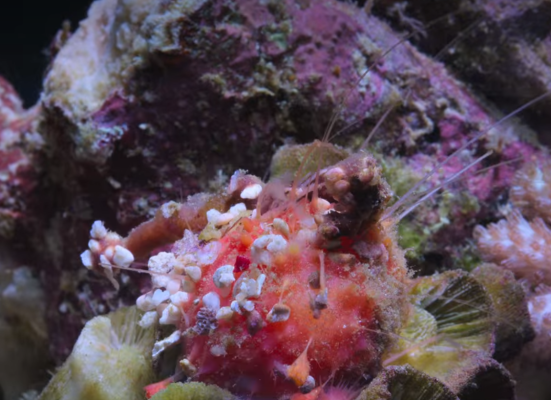
Fig4. Marine Snow floating in the water column of the Great Barrier Reef
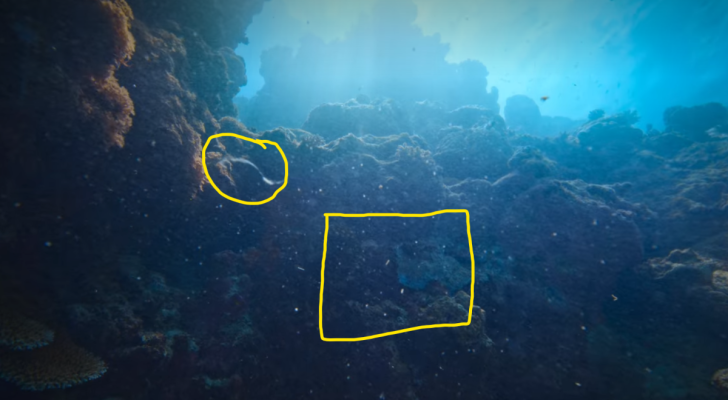
FOOD SCOURCES AVAILABLE:
I'm going to mention a forgotten food source. In Fig. 4 we see slime (circled). Slime originates, in large part, from corals that produce mucus as a feeding response or for defensive purposes when stressed. Slime producers are Euphyllia, Duncanopsammia, Blasotmussa, and more (be cautious of aggressive slimers such as Acropora that could possibly injure or kill nearby coral colonies). I believe that Slime is one of the food sources that most of us forget about and should maybe include more of in our systems. It is often forgot that filter feeders and, possibly other corals such as Goniopora, consume slime and mucus. We add micro-crustaceans, phytoplankton and organic particulate foods or engineered foods like Reef Roids and more. So why not let that slime flow around? I will be contacting experts and devise a test to confirm if Goniopora respond to slime in the way a Sea Sponge would.
Another, more well-known source, is detritus. Detritus is found in the water column of reefs around the world and the zones Goniopora are found in are no exception. Therefore, occasionally ramping up powerheads to kick up/stir up detritus to provide a supplemental food source with the added benefit of removing an undesired NO3 and PO4 source is a no-brainer. There is another further possibility that other corals such as Euphyllia which are found in more turbid waters that could also appreciate the extra detritus. But what is detritus? It's a bit complicated and depending on what biome you're observing it in, it's composition changes. While detritus is a general term that applies to a mix of dissolved and dissolving organic and inorganic matter, when the deposition layer (the "floor" where the detritus rests) is on the sea floor, it is usually referred to as Marine Snow.
Marine snow (highlighted in the square from Fig 4. ) is composed of dead or dying animals that are planktonic in size to "pod size" (think of the dead micro-crustaceans you occasionally see floating in your tank) or even bits of organic matter from larger dead aquatic life, fecal matter, sand, dust from coral rubble or calciferous stone, phyto and zooplankton, bacteria and all the natural polymers those planktonic organisms excrete which also includes mucus and slimes. Particle sizes range from one nanometer to around a few micrometers and as we know, marine snow is consumed by filter feeders. Furthermore, it is a continuous source that never goes away. It may vary in abundance during algal blooms but it is always present. I think we should pay close attention to the particle size of foods based on studies indicating that Goniopora do not feed on larger particle sizes. This food source likes to congregate in areas where we see Sea Sponges and oddly enough, Goniopora. Marine snow forms in the upper layers of the water column all the way down to the sea floor. It tends to begin to congregate at around 100m down and will eventually settle on the sea floor. There are also multiple stages to Marine Snow, and we could see that some of the particle sizes are relatively small in the photos of Goniopora. This indicates to us that we are higher up, but we are starting to get down to that lower 100m threshold. Therefore, we still have some bioavailability in the marine snow, and I will be looking into this some more.
Fig 5.1 :
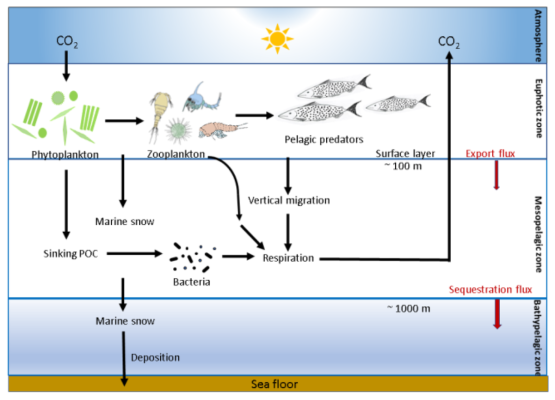
This might suggest something about where we may find Goniopora in the wild. Also, it brings up questions about lighting and flow that we have no way of confirming as hobbyists as of right now. For the sake of not rambling on more than I have, I won’t go into the details of all the biological benefits marine snow has as being the carbon pump for the ocean, but I will provide links for those who would like to read further. Just know that this is a highly important component of the ocean as a food source alone and I will be developing a method to ensure that at least at some part of the day, I will be providing my own reef snow to my tank in ways that have positive biological effects. Pictures and explanations are soon to come. I am aware that there are commercially available marine snow like products but there is no way of knowing what is in them with 100% certainty. Additionally, the matter in marine snow came from something that had a function in the ocean and I would like to maintain that aspect. If we can utilize the components of marine snow to provide a function/service to our tanks and coral, all the better.
Fig 5.2 . Marine Snow
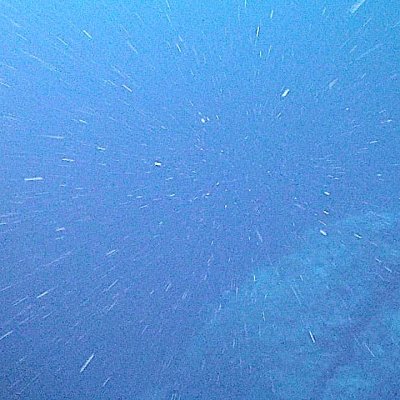
A new venture we are starting to see some reefers looking into these new "pro-biotic" regiments that adjust and provide additional bacteria sources which may also provide some lesser-known benefits we have yet to discover. It is my belief that this is probably the segment with the greatest potential for growth in knowledge and possibly holds great potential. We are starting to see that even corals themselves are culturing their own bacterial cultures around and within themselves to improve their health, survivability and perhaps even nutrient uptake. This is an extremely new field of study even within the scientific community is still a not fully understood. This could possibly hold similar importance to the culture and consumption of phytoplankton, zooplankton and micro-crustaceans.
Planktonic foods. They are good for many things but are we certain that goniopora consume them? There is some indication that Goniopora possibly don't process phytoplankton. There are many types of sponges and filter filters that utilize planktonic foods, and they can manage nuisance microalgae as well. So even if Goniopora don't consume phyto it still can serve your microcrustaceans and as part of our cuc regiment.
This brings me to microcrustaceans/pods. Another one where I would say just have them or add them. The benefits are too great to not have them. I have observed Goniopora actively catching and consuming smaller juvenile live "pods" in still water and they do not reject them later indicating a possible food source, but we can be sure. Honestly, there isn't much data here so I wouldn't know if they would benefit from it. There is even some data showing that they may not be able to consume the larger foods of this size. However, that being said "pods" are great for our fish and other coral. Also, dead or dying micro-crustaceans like those floating out from a refugium into the DT provided some sort of function prior to their demise so if we can use that function and gain the benefits of their value as reef snow, that is a win-win. This may be a moot point for those who already have substantial micro-crustacean populations due to a fuge but it is my belief that we don't realize just how important those little critters are.
Lastly, this brings me to commercially available foods such as powders and pellets. There isn't much that we can be certain of here due to lack of studies. Some studies are showing that Goniopora don't really process commercial foods either, but data is sparce. I have noticed that my current Goniopora produce a slime that pulls in powdered food when flow is off. The colony reacts with a mixture of foods. I use Reef Roids, Vitalis Mixed Reef Food, Poly Lab Polyp Booster and AB+ mixed together in a separate cup and administered with a turkey baster (I will follow up with mixing ratios). I also broadcast Phytoplankton 5 minutes before. So maybe there is so minor benefit, but I can't be certain. I'm not going to stop, and I have seen others mention that possibly they do help the coral's survival rate.
So that leaves us with smaller particulate sizes that are more likely to be captured by goniopora. Hopefully we can make better use of those sizes in out tanks.
Fig. 6 A large Goniopora colony in the Great Barrier Reef surrounded by Marine Snow
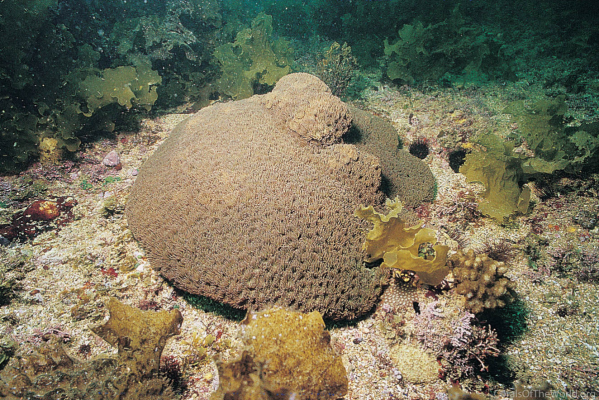
Now that we can assume Goniopora are found with filter feeding organisms and these food sources, we can also make a rather educated guess that Goniopora would also appreciate the same foods and food availability that is optimized for Sea Sponges and other filter feeders. This is not an entirely new idea and has even been recommended among some hobbyists for quite some time now. Using this information I've begun making some changes to my system. I've started the implementation of a new system that doses live juvenile micro-crustaceans 24/7 from a grow out system to a temporary holding reservoir. The holding reservoir acts as a staging area for the live micro-crustaceans to sit at a higher concentration than what would be possible in the grow-out reservoir. The holding reservoir is the final stage where they are then dosed into a powehead for distribution for coral, filter feeders and fish to consume. I also have implemented a fuge reactor to provide a home from micro-crustaceans. I have slowly ramped up a small carbon dosing regiment as to not overdose my system and strip out all nitrate from my water column.
To conclude, it appears we are going in the right direction with Goniporas and further understanding the environment Goniopora originate from will hopefully help us decrease moralities from diseases, shipping stress or propagation injuries. So, in short, perhaps we should be treating Goniopora as a filter feeding organism that enjoys the types of foods that we normally see with sea sponges. I will be sharing the changes I've made to my system here later. All the photos provided are available below in their original sizes. Please do share your experiences and thoughts.
Sources:

 www.ncbi.nlm.nih.gov
www.ncbi.nlm.nih.gov

 www.reef2reef.com
www.reef2reef.com

 academic.oup.com
academic.oup.com

 www.ncbi.nlm.nih.gov
www.ncbi.nlm.nih.gov

 en.wikipedia.org
en.wikipedia.org

 en.wikipedia.org
en.wikipedia.org
 tidalgardens.com
tidalgardens.com
 www.marinespecies.org
Fig. 1 : http://www.coralsoftheworld.org/media/images/0198_C04_01.jpg
www.marinespecies.org
Fig. 1 : http://www.coralsoftheworld.org/media/images/0198_C04_01.jpg
Fig. 2 : https://en.wikipedia.org/wiki/Puff:_Wonders_of_the_Reef
Fig. 3 : https://en.wikipedia.org/wiki/Puff:_Wonders_of_the_Reef
Fig. 4 : Fig. 5.2 : By NOAA National Ocean Service - Extracted from this Commons image(see [1]), Public Domain, https://commons.wikimedia.org/w/index.php?curid=86227762
Fig. 5.1 : By Samarpita Basu and Katherine R. M. Mackey - [1]doi:10.3390/su10030869, CC BY-SA 4.0, https://commons.wikimedia.org/w/index.php?curid=92665968
Fig. 6 : http://www.coralsoftheworld.org/media/images/0198_C01_03.jpg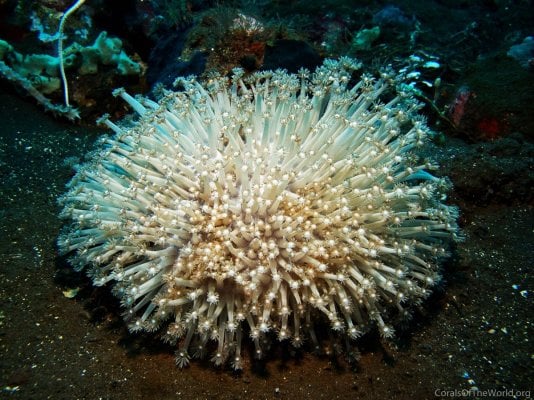
To moderators: Please let me know if this should be placed in a different thread category.
Disclaimer: I am just a curious hobbyist looking into the natural state of coral to best reproduce an optimized environment for the corals we keep. I will also be making a lot of assumptions and do not have the resources to confirm, with 100% certainty, the claims made in this post as of yet. I am hoping to get the ball rolling for us to start thinking in a different way about Goniopora. I encourage others to chime in and post their findings as well. I do not suggest anyone make any drastic changes to their systems and/or going full hog by dumping food into their system causing a nutrient bloom. Always accept the risks associated with this hobby and do your own research first. And,YES! I know we already know to feed Goniopora a lot, but now I feel I might have some confirmation and, hopefully, you also have more confidence we are doing right by our corals.
I remember a time when Goniopora was considered an impossible coral. We have certainly come to a point where there isn't much of a struggle anymore. However, after noticing a pattern in images of wild colonies, I thought I'd share my findings. I noticed that Goniopora were in areas of the reef with higher turbidity and were often found in very close proximity to Sea Sponges, Sea Squirts, and other filter feeders such as Gorgonians.
Fig.1 A Goniopora colony in still water next to multiple types of filter feeders in Indonesia


Fig.2 Goniopora colonies in the Great Barrier Reef near Sea Sponges
We can see in the highlighted regions, filter feeding organisms that consume food that would also theoretically be available to the surrounding Goniopora colonies. As we know, sponges and other filter feeders appreciate a constant supply of planktonic foods and detritus which we can see here in Fig. 3 and Fig. 4. Could we be leaving out certain types of food? Do we produce the optimal nutrient environment for this coral? Let's take a deeper dive into that topic (pun intended).
Fig. 3 A small sponge from the same rock formation in Fig. 2

Fig4. Marine Snow floating in the water column of the Great Barrier Reef

FOOD SCOURCES AVAILABLE:
I'm going to mention a forgotten food source. In Fig. 4 we see slime (circled). Slime originates, in large part, from corals that produce mucus as a feeding response or for defensive purposes when stressed. Slime producers are Euphyllia, Duncanopsammia, Blasotmussa, and more (be cautious of aggressive slimers such as Acropora that could possibly injure or kill nearby coral colonies). I believe that Slime is one of the food sources that most of us forget about and should maybe include more of in our systems. It is often forgot that filter feeders and, possibly other corals such as Goniopora, consume slime and mucus. We add micro-crustaceans, phytoplankton and organic particulate foods or engineered foods like Reef Roids and more. So why not let that slime flow around? I will be contacting experts and devise a test to confirm if Goniopora respond to slime in the way a Sea Sponge would.
Another, more well-known source, is detritus. Detritus is found in the water column of reefs around the world and the zones Goniopora are found in are no exception. Therefore, occasionally ramping up powerheads to kick up/stir up detritus to provide a supplemental food source with the added benefit of removing an undesired NO3 and PO4 source is a no-brainer. There is another further possibility that other corals such as Euphyllia which are found in more turbid waters that could also appreciate the extra detritus. But what is detritus? It's a bit complicated and depending on what biome you're observing it in, it's composition changes. While detritus is a general term that applies to a mix of dissolved and dissolving organic and inorganic matter, when the deposition layer (the "floor" where the detritus rests) is on the sea floor, it is usually referred to as Marine Snow.
Marine snow (highlighted in the square from Fig 4. ) is composed of dead or dying animals that are planktonic in size to "pod size" (think of the dead micro-crustaceans you occasionally see floating in your tank) or even bits of organic matter from larger dead aquatic life, fecal matter, sand, dust from coral rubble or calciferous stone, phyto and zooplankton, bacteria and all the natural polymers those planktonic organisms excrete which also includes mucus and slimes. Particle sizes range from one nanometer to around a few micrometers and as we know, marine snow is consumed by filter feeders. Furthermore, it is a continuous source that never goes away. It may vary in abundance during algal blooms but it is always present. I think we should pay close attention to the particle size of foods based on studies indicating that Goniopora do not feed on larger particle sizes. This food source likes to congregate in areas where we see Sea Sponges and oddly enough, Goniopora. Marine snow forms in the upper layers of the water column all the way down to the sea floor. It tends to begin to congregate at around 100m down and will eventually settle on the sea floor. There are also multiple stages to Marine Snow, and we could see that some of the particle sizes are relatively small in the photos of Goniopora. This indicates to us that we are higher up, but we are starting to get down to that lower 100m threshold. Therefore, we still have some bioavailability in the marine snow, and I will be looking into this some more.
Fig 5.1 :

This might suggest something about where we may find Goniopora in the wild. Also, it brings up questions about lighting and flow that we have no way of confirming as hobbyists as of right now. For the sake of not rambling on more than I have, I won’t go into the details of all the biological benefits marine snow has as being the carbon pump for the ocean, but I will provide links for those who would like to read further. Just know that this is a highly important component of the ocean as a food source alone and I will be developing a method to ensure that at least at some part of the day, I will be providing my own reef snow to my tank in ways that have positive biological effects. Pictures and explanations are soon to come. I am aware that there are commercially available marine snow like products but there is no way of knowing what is in them with 100% certainty. Additionally, the matter in marine snow came from something that had a function in the ocean and I would like to maintain that aspect. If we can utilize the components of marine snow to provide a function/service to our tanks and coral, all the better.
Fig 5.2 . Marine Snow

A new venture we are starting to see some reefers looking into these new "pro-biotic" regiments that adjust and provide additional bacteria sources which may also provide some lesser-known benefits we have yet to discover. It is my belief that this is probably the segment with the greatest potential for growth in knowledge and possibly holds great potential. We are starting to see that even corals themselves are culturing their own bacterial cultures around and within themselves to improve their health, survivability and perhaps even nutrient uptake. This is an extremely new field of study even within the scientific community is still a not fully understood. This could possibly hold similar importance to the culture and consumption of phytoplankton, zooplankton and micro-crustaceans.
Planktonic foods. They are good for many things but are we certain that goniopora consume them? There is some indication that Goniopora possibly don't process phytoplankton. There are many types of sponges and filter filters that utilize planktonic foods, and they can manage nuisance microalgae as well. So even if Goniopora don't consume phyto it still can serve your microcrustaceans and as part of our cuc regiment.
This brings me to microcrustaceans/pods. Another one where I would say just have them or add them. The benefits are too great to not have them. I have observed Goniopora actively catching and consuming smaller juvenile live "pods" in still water and they do not reject them later indicating a possible food source, but we can be sure. Honestly, there isn't much data here so I wouldn't know if they would benefit from it. There is even some data showing that they may not be able to consume the larger foods of this size. However, that being said "pods" are great for our fish and other coral. Also, dead or dying micro-crustaceans like those floating out from a refugium into the DT provided some sort of function prior to their demise so if we can use that function and gain the benefits of their value as reef snow, that is a win-win. This may be a moot point for those who already have substantial micro-crustacean populations due to a fuge but it is my belief that we don't realize just how important those little critters are.
Lastly, this brings me to commercially available foods such as powders and pellets. There isn't much that we can be certain of here due to lack of studies. Some studies are showing that Goniopora don't really process commercial foods either, but data is sparce. I have noticed that my current Goniopora produce a slime that pulls in powdered food when flow is off. The colony reacts with a mixture of foods. I use Reef Roids, Vitalis Mixed Reef Food, Poly Lab Polyp Booster and AB+ mixed together in a separate cup and administered with a turkey baster (I will follow up with mixing ratios). I also broadcast Phytoplankton 5 minutes before. So maybe there is so minor benefit, but I can't be certain. I'm not going to stop, and I have seen others mention that possibly they do help the coral's survival rate.
So that leaves us with smaller particulate sizes that are more likely to be captured by goniopora. Hopefully we can make better use of those sizes in out tanks.
Fig. 6 A large Goniopora colony in the Great Barrier Reef surrounded by Marine Snow

Now that we can assume Goniopora are found with filter feeding organisms and these food sources, we can also make a rather educated guess that Goniopora would also appreciate the same foods and food availability that is optimized for Sea Sponges and other filter feeders. This is not an entirely new idea and has even been recommended among some hobbyists for quite some time now. Using this information I've begun making some changes to my system. I've started the implementation of a new system that doses live juvenile micro-crustaceans 24/7 from a grow out system to a temporary holding reservoir. The holding reservoir acts as a staging area for the live micro-crustaceans to sit at a higher concentration than what would be possible in the grow-out reservoir. The holding reservoir is the final stage where they are then dosed into a powehead for distribution for coral, filter feeders and fish to consume. I also have implemented a fuge reactor to provide a home from micro-crustaceans. I have slowly ramped up a small carbon dosing regiment as to not overdose my system and strip out all nitrate from my water column.
To conclude, it appears we are going in the right direction with Goniporas and further understanding the environment Goniopora originate from will hopefully help us decrease moralities from diseases, shipping stress or propagation injuries. So, in short, perhaps we should be treating Goniopora as a filter feeding organism that enjoys the types of foods that we normally see with sea sponges. I will be sharing the changes I've made to my system here later. All the photos provided are available below in their original sizes. Please do share your experiences and thoughts.
Sources:

Feeding of a Scleractinian Coral, Goniopora columna, on Microalgae, Yeast, and Artificial Feed in Captivity
Coral aquaculture is an innovative and sustainable aquaculture industry. Coral husbandry can address ecological environment conservation needs and industrial demand for corals. Many previous studies have confirmed that corals also belong to heterotrophic ...

Artificial PUFA rich in animal protein? Interesting Goniopora Study
@Randy Holmes-Farley This was a very interesting study: Feeding of a Scleractinian Coral, Goniopora columna, on Microalgae, Yeast, and Artificial Feed in Captivity Here are some quotes from the study: Although the species has noteworthy ornamental value, research has indicated that the...
 www.reef2reef.com
www.reef2reef.com

Coral mucus rapidly induces chemokinesis and genome-wide transcriptional shifts toward early pathogenesis in a bacterial coral pathogen
AbstractElevated seawater temperatures have contributed to the rise of coral disease mediated by bacterial pathogens, such as the globally distributed Vibr

The coral microbiome: towards an understanding of the molecular mechanisms of coral–microbiota interactions
Corals live in a complex, multipartite symbiosis with diverse microbes across kingdoms, some of which are implicated in vital functions, such as those related to resilience against climate change. However, knowledge gaps and technical challenges limit ...

Detritus - Wikipedia

Marine snow - Wikipedia
Tidal Gardens - Goniopora Coral Care
This article is all about Flowet Pot Corals of the Genus Goniopora.
WoRMS - World Register of Marine Species - Goniopora de Blainville, 1830
Fig. 2 : https://en.wikipedia.org/wiki/Puff:_Wonders_of_the_Reef
Fig. 3 : https://en.wikipedia.org/wiki/Puff:_Wonders_of_the_Reef
Fig. 4 : Fig. 5.2 : By NOAA National Ocean Service - Extracted from this Commons image(see [1]), Public Domain, https://commons.wikimedia.org/w/index.php?curid=86227762
Fig. 5.1 : By Samarpita Basu and Katherine R. M. Mackey - [1]doi:10.3390/su10030869, CC BY-SA 4.0, https://commons.wikimedia.org/w/index.php?curid=92665968
Fig. 6 : http://www.coralsoftheworld.org/media/images/0198_C01_03.jpg

























